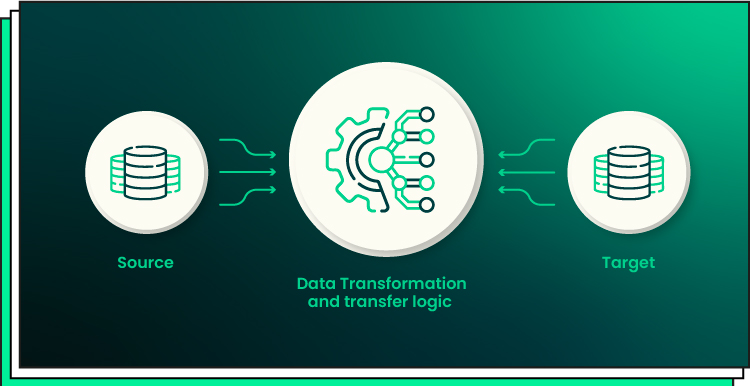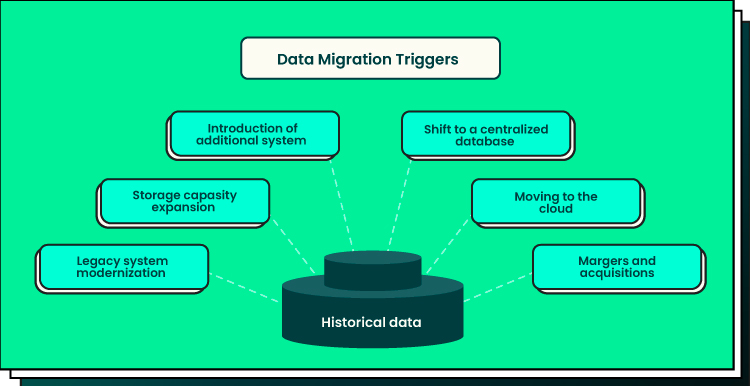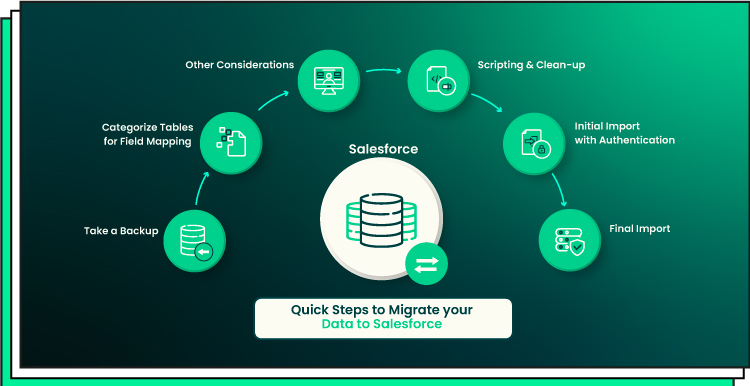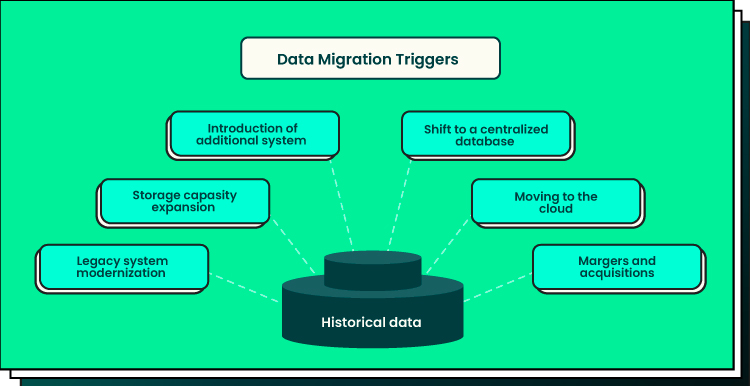In this article, we will delve into the details of data migration testing. We’ll consider how this process is generally executed and offer the optimal workflow, explaining hypotheses that underlie each step. To ensure perfect outcomes of data migration and mitigate the associated risks of data corruption and errors, it’s inevitable to implement a deep and all-encompassing data migration test routine. By adopting this approach, we strive to attain the most accurate and appropriate results throughout the data migration process.
Data migration unfolds as a crucial, multi-step process that commences with the meticulous analysis of legacy data and culminates in the exhilarating upload and harmonization of data in cutting-edge applications. In today’s data-driven world where organizations experience exponential data growth, the need for seamless data migration becomes a constant requirement, as many companies migrate to the cloud or between different IT systems.
However, the repercussions of poorly organized and inadequately tested data migration can be significant and painful. Let’s list the potential consequences of ignoring data migration testing:
- Data loss or business information inaccuracy;
- Corruption of critical data used in key business operations;
- Incomplete or erroneous transfers between business entities;
- Compromised reliability and usefulness of the migrated data;
- Disruptions in business applications being migrated;
- Data theft and breaches (this can come with painful legal penalties);
- Flawed business intelligence and decision-making;
- Inefficient functionality of high-end business AI-powered applications;
- Extended system downtime and difficulties in business operations, customer experience, and overall productivity.

In this context, data migration testing protects the integrity of your valuable databases and guarantees smooth system functionality and security during the transfer of your company’s data sets to alternative hosting environments. The complexity of migrations varies based on factors such as the size and nature of your organization as well as the intricacies of your operations.
Whether your data migration is highly technical or relatively straightforward, adopting rigorous testing practices, including a comprehensive data migration test strategy, becomes instrumental in preserving the accuracy and reliability of your data throughout the transition. In this article, we will delve into the best practices for database migration testing, emphasizing its importance and providing practical guidance for conducting effective testing throughout the pre-migration, migration execution, and post-migration phases.
If you require data migration services to move the content of your organization’s servers, databases, and applications to new destinations and platforms, please contact us for immediate IT consulting and engineering.
Planning for Data Migration Testing: Best Practices in the Pre-migration Phase
In the fast-paced realm of modern business where data reigns supreme, it is paramount to meticulously strategize, plan, and organize all sub-processes of data migration testing. These critical preparations lay the foundation for safeguarding the integrity of your valuable data sets and systems as they are getting moved to a new hosting platform or application. In a well-written data migration testing plan, IT engineers:
- Outline risks: Navigate through the challenges involved in transferring your information and avoid typical mistakes or never face any complex and exotic issues with specific data migration testing procedures.
- Outline data structure: Ensure seamless and secure data transition along with preserving its holistic state, which means keeping comprehensive format, tables, relations, and other crucial data parameters.
- Outline necessary data transformation: Allow correct data re-formatting and modification for efficient uptake into all new business applications and other recipient systems involved in the migration processes.
Identify The Context of Your Data Migration Testing
Only with a properly written and professionally executed project plan, you can prevent potential issues that could compromise the accuracy, completeness, and consistency of your valuable business information. The first step includes selecting the type of data migration you adhere to:
Storage Migration
This type of migration focuses on transitioning between storage technologies or capacities, including scenarios such as moving data from local servers to cloud storage to make use of the scalability and accessibility specific to the cloud platforms. It also encompasses the conceptual shift from legacy magnetic disks to faster and more reliable solid-state drives (SSDs) or upgrading to hardware with larger storage and operation capacity.
Database Migration
This approach involves transferring data from one database management system (DBMS) to another. For instance, moving data from Microsoft SQL Server to Oracle Database or vice versa. It can also include moving data from an outdated DBMS, like MS Access, to an up-to-date system with streamlined performance and a wider set of features. Businesses may opt to switch between different database vendors to align with their evolving needs and preferences. An exact configuration and migration terms can be identified in the process of technical due diligence.
Application Migration
This type involves the transfer of records between different applications and is commonly performed during software upgrades. For example, when implementing a new customer relationship management (CRM) system, businesses must ensure the accurate and seamless migration of customer data. This includes preserving customer profiles, essential data fields, values, and analytical insights, ensuring that all relevant information is effectively moved and reconstructed in the new platform.
Cloud Migration
This refers to the process of moving business records and applications from on-premises hardware or IT infrastructure to cloud-based platforms on the web. Organizations can transfer their data and related services to leverage cloud environments’ scalability, flexibility, accessibility, and cost-effectiveness. This migration enables businesses to embrace cloud computing resources and reduce their dependency on physical infrastructure.
Platform Migration
This type focuses on moving records and applications from one operating system to another, like switching between Windows-driven servers to Linux platforms, or vice versa. Organizations may decide to transition between operating systems to pursue new features, change development paradigms, improve software compatibility, or optimize their financial strategies. Additionally, businesses might migrate between cloud platform providers based on their legal conditions, growing technical needs, and user preferences.

Prepare Your Data Migration Testing Checklist
Before embarking on the data migration process, it is essential to follow a pre-migration testing checklist. If you require help with the planning and execution of data migration in your company, our IT engineers can professionally help you.
Here are the key steps to consider in terms of pre-migration testing:
Migration Scope Definition
Begin by clearly defining the scope of your migration. This involves identifying the specific data sets, metrics, applications, and systems that will be part of the migration process. By providing a distinct definition of the subject and goals of your migration operations, you can establish a clear vision of what data will be moved, how it will be moved, and its intended destination. This clarity helps ensure the accuracy and integrity of the data during the testing phase, preventing any confusion or errors.
Database Health Checking
Prior to migrating any business records, it is essential to perform a thorough assessment of the database’s health. This inspection encompasses a review of crucial elements: database design, schema, indexing, and query performance to identify any potential inefficiencies or bottlenecks that could adversely affect the system’s overall performance. To achieve this, specific procedures must be executed to evaluate the configuration of the data structure, data safety measures, index efficiency, database maintenance protocols, and the presence of incomplete or corrupted data.
Mapping the Migration Flow
Develop a comprehensive plan that precisely outlines the steps required to transfer data from the source storage to the target system. This involves creating a detailed roadmap that incorporates any necessary transformations, reformatting, or data-mapping requirements specific to the target system. Before proceeding with the full-scale migration, it is recommended to test the approach with a smaller batch of records, allowing you to carefully map the migration flow and identify any potential data migration challenges or complexities. This proactive testing approach enables you to address issues on a smaller scale, minimizing the impact on larger sets of data and ensuring a smoother and more successful migration process.
Backup Data Plan
Prior to the database migration, it is crucial to create reserve copies of your records in secure storage systems that will remain unaffected by the migration. This serves as an extra layer of protection and ensures that your data is easily recoverable in case of any unforeseen issues during the migration.
Establishing the Budget &Timelines
Collaborate closely with the migration team and business stakeholders to agree upon budget and timeline expectations for the data migration project (sometimes, it’s necessary to allocate more time for successful technical research & preparation.) By doing so, you ensure that all stakeholders are aligned and fully aware of the financial and temporal commitments necessary for a successful migration. This proactive approach promotes transparency and accountability so all the process stakeholders embrace the importance of data migration.
Security and Compliance Alignment
It’s imperative to safeguard against potential data breaches and interception attacks. It takes verifying that both the legacy and new systems, as well as the IT engineers involved in the migration, adhere to the relevant standards of security. privacy, and compliance. This entails conducting a thorough assessment of data protection measures, access controls, and industry-specific regulations to ensure the confidentiality, integrity, and availability of the migrated data.

Data Migration Testing Best Practices: Types & Methods
These methods are involved in every efficient data migration testing strategy and must be executed by skilled testing engineers under the supervision of qualified tech project managers. Also, these engineers will define a specific combination and spectrum of testing tools to be applied for the best result.
At Forbytes, we recommend that you implement test automation as one of the best practices that can significantly enhance efficiency. Our QA engineers are ready to provide you with consulting on these matters. Meanwhile, learn more about the major data migration testing approaches:
Data Migration Functionality Testing
This data migration test method is essential for ensuring that the migrated data retains its intended functionality and operates as expected in the target system. This type of testing focuses on:
- Validating data integrity and quality
- Testing data relationship functionality
- Comparison to previous database performance levels
- Applying real-life use scenarios to software products fueled with migrated data
- Checking adherence to business rules and limitations.
In functionality database migration testing, one of the key aspects involves querying the recipient software system or DBMS to assess how well it retrieves the required data from the database and evaluate the quality of the response.
Additionally, it entails working with the recipient software to verify if it correctly functions with the received data content. By conducting functionality testing, QA engineers can confidently ensure that the migrated data performs its intended tasks accurately, aligning with the desired outcomes of the migration process. In other words, you make sure that the operations have really improved as expected.
Data Migration Performance Testing
A crucial technique that centers around evaluating the efficiency of the data migration process in technical terms. It involves assessing various factors, including:
- Measuring data transfer speed and response times
- Catching error occurrences and troubleshooting
- Checking resource utilization metrics throughout the migration workflow.
By conducting deeper performance testing, organizations can effectively identify and address any bottlenecks, optimize data transfer efficiency, and ensure that the migration process does not have a detrimental impact on system performance.
Moreover, the insights gained from data migration performance testing can aid in the cost management of cloud platform services, allowing organizations to optimize their resource allocation based on the observed data transfer performance.
Data Migration Security Testing
Security testing is crucial in protecting the migrated data from potential vulnerabilities and breaches. This involves evaluating:
- Access controls
- User permissions & protection
- Application encryption measures
- Data transmission methods and environments
- Data masking techniques.
Moreover, it covers vulnerability assessments in each and every way imaginable. Through rigorous security testing, any weaknesses or gaps in the security measures can be discovered and remedied, bolstering the overall protection of the data and reducing the potential for security breaches, minimizing the risk of data exploitation or unauthorized access. By the way, data security inspection and vulnerability examination can be automatically executed with the help of cybersecurity AI and ML methods.
Compliance Testing in Data Migration
During the data migration process, it is crucial to prioritize adherence to applicable data protection regulations and industry standards. This entails verifying that the migrated data as well as recipient applications align with specific compliance requirements, such as GDPR (General Data Protection Regulation) in the European Union or HIPAA (Health Insurance Portability and Accountability Act) in the United States. By executing thorough compliance testing, you can:
- Safeguard the integrity and privacy of the migrated data
- Mitigate the risk of potential legal and regulatory complications
- Avoid unforeseen financial implications.
Ensuring compliance throughout the data migration process is fundamental for maintaining trust and upholding the reputation of the organization.

Migration Testing Checklist: Best Practices in Data Transition Test Execution & Reporting Phase
1. Break Your Migration into Portions
Dividing the entire process into smaller, manageable batches not only helps with gradual testing and step-by-step validation but also allows for granular and efficient testing control. By testing smaller subsets of data at a time, you can identify and resolve any issues or inconsistencies with better control and visibility, minimizing the impact on production systems and enabling quicker remediation if any problems arise.
2. Verify Your Migration Scripts
Ensure that the migration scripts or tools are used accurately and reliably to move the data from the source data storage to the recipient system. Let professional programmers test and validate the scripts to confirm their optimal functionality and correctness. This includes checking for any code errors, mapping discrepancies, and identifying data loss or mutation during the limited data migration tests.
3. Complete Data Validation Testing
Validate the integrity and accuracy of the migrated data via the methods described in the earlier sections. This involves comparing the source and data structures unpacked at the target location. QA engineers must verify that all data elements, relationships, and business rules were maintained during the migration to ensure consistency and completeness. By validating the data, you can identify any data discrepancies or anomalies early on and take corrective actions to ensure data quality.
4. Set User Access Parameters
As a part of the data migration test process, review and establish user roles and access parameters for the new systems. Define permissions to ensure that each user within the organization has the appropriate level of access to the migrated data and systems. This involves granting or revoking user privileges, setting up role-based access controls, and implementing secure authentication mechanisms.
5. Execute Test Data Management
Implementing effective test data management is crucial for successful data migration testing. It involves strategically organizing and orchestrating your QA testing team and cases, ensuring they have access to the data sets and environments for sophisticated testing procedures. By adopting an intelligent approach to test data management, organizations can ensure that the testing process aligns with the overall migration plan, objectives, and expected results.
6. Test Execution Reporting
Systematic test execution and detailed reporting are crucial elements of data migration testing and improvement. Following the testing plan and accomplishing test cases based on priority ensures comprehensive coverage. Effective defect management in data migration testing involves the following essential activities: logging migrated data defects, documenting steps to reproduce issues, tracking progress, and generating comprehensive test reports that summarize test coverage, pass/fail status, and identified issues. All of these things are vital for effective communication within the data migration team and making correct engineering decisions.
Best Practices to Be Included in Post-Migration Testing Checklist
- Conduct a comprehensive end-to-end audit of software workflows to gain a holistic perspective of the migration’s success.
- Validate the integrity of data in the new systems by comparing it to the structures and assets of the legacy systems.
- Accurately test the data arrays for any incompatibilities and eliminate data duplication to optimize system efficiency. Data health examination checks can be carried out by qualified data science engineers, who can readily become a part of your data migration team.
- Evaluate system performance under stress conditions and assess its ability to handle high volumes of data and user demands.
- Verify and configure user access levels to guarantee appropriate permissions for the new systems, maintaining data confidentiality and integrity.
- Engage business application users, data owners, and subject matter experts to help identify critical data elements, ensuring their accuracy and relevance.
Conclusion
In the fast-paced digital landscape affected by non-stop digital transformation, data migration testing is an important step for organizations to ensure a successful business operation and the security of their valuable data.
With Forbytes, a trusted IT company renowned for its expertise in data migration services, you can confidently navigate this complex process. Our team of skilled professionals employs advanced testing methodologies to ensure data integrity, functionality, and security throughout the migration journey. Contact us today for more information.

Our Engineers
Can Help
Are you ready to discover all benefits of running a business in the digital era?

Our Engineers
Can Help
Are you ready to discover all benefits of running a business in the digital era?







